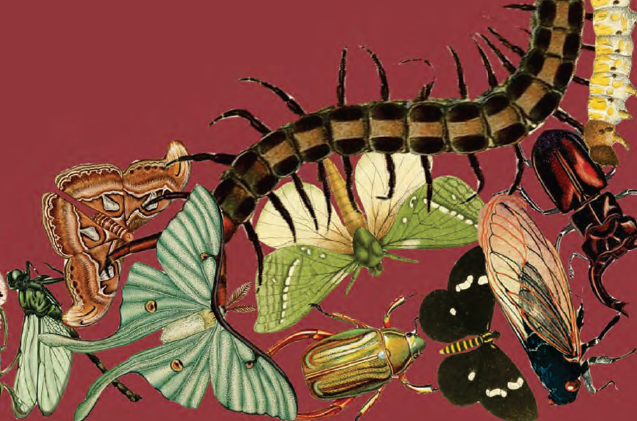by Thuy-Tien Bui
On rare occasions, you might be able to spot the endangered mission blue butterfly fluttering around lupine flowers in the coastal grasslands of San Francisco Bay. This beautifully iridescent butterfly was one of the first species added to the endangered species list in 1976 after losing its specialized grassland habitat to urbanization, development, and more recently, the encroachment of invasive plants. The mission blue is still endangered today, surviving only in parts of the Golden Gate National Recreation Area, Twin Peaks, and San Bruno Mountain. The story of the mission blue serves as a cautionary tale of the anthropogenic impacts on insect populations, which are declining at an alarming rate.
In large part due to habitat loss, climate change, and pesticide use, an estimated 40% of insect species are declining globally and many are silently slipping toward extinction at a rate eight times faster than mammals and birds. Although living in a world without insects might seem like paradise—no more itchy mosquito bites, annoying flies buzzing around your ear, or creepy-crawlers living in your home rent-free—we can’t exist without them. We rely on insects to pollinate essential crops, break down waste, aerate soil, biologically control other insect pests, and form the base of the food web for larger animals, including humans. With the hypothetical insect-free “paradise” becoming a concerning reality, habitat restoration and changes in agriculture practices are necessary to slow or prevent further declines in insect populations and to support the tiny organisms that shape our ecosystems.
The current warming trend is causing insect species to shift their distribution north to avoid unfavorable heat and to follow the range shifts of their host plants. Species typical of high altitudes are now more prone to range contractions and extinction due to the encroachment of species shifts. Climate change is also creating a shift in seasons: winters are shorter, spring is arriving earlier, and summers are getting longer. As a result, the life cycles of plants, insects, and larger species that eat insects are no longer as synchronized, initiating a cascade of problems through the trophic system. As warming climates threaten the survival of fragile butterflies, moths, and bees, conditions are becoming ripe for persistent pests like mosquitoes and cockroaches that better adapt to the changes we have triggered.
The DDT pesticide that threatened charismatic wildlife like the bald eagle was successfully banned in 1972 following the influence of Rachael Carson’s cautionary novel, Silent Spring. While the pesticides that replace DDT are generally less harmful to wildlife, they are actually more toxic to insects. Neonicotinoids, widely used insecticides on farms and urban landscapes, accumulate in the pollen and nectar of plants and are 7,000 times more toxic to bees than DDT. A comprehensive report on the status of European butterfly species found that 80% of species are negatively affected by pesticides. The monarch butterfly provides a notable example. Its populations have declined more than 80% in the last 20 years largely due to glyphosate pesticides killing their specialized host milkweed plant.
Given the vital ecosystem services provided by insect pollinators, these numbers are concerning. Over 150 food crops grown in the U.S., including nearly all fruit and grain crops, depend on insect pollination to reproduce and generate higher, tastier yields. Some crops like almonds rely entirely on bee pollination—without honey bees, the trees can’t produce nuts. In the last 50 years, there has been a 300% increase in the volume of agricultural production dependent on pollinators, including species less popular than honey bees, such as midges, wasps, and beetles. At a time when the human population continues to grow and there are more mouths to feed, the severe strain placed on pollinators is expected to worsen the global food security crisis.
Some experts might disagree with the concern over insects, pointing out their historical resilience and the fact that the abundance of some species is increasing in some areas. However, a 2019 review on global insect decline determined that the growing species are adaptable generalists that opportunistically occupy the vacant niches left by the many species that are declining. And while certain Northern Europe butterfly species are expanding their range, the decline in half of the world’s insects counter this trend. Although insects are resilient organisms that have managed to survive through five mass extinctions, it is unlikely that they will adapt fast enough to keep up with current accelerating rates of global change.
Fortunately, there is enough evidence about insect declines to begin addressing the main causes. We can start by dialing back on pesticide use by employing insects for biological control or making less harmful organic and biopesticides more widely available. Farmers can establish buffer zones of wildflowers at the edge of monoculture fields to support insects that help their crops grow. Then, there’s always the easy solution of embracing natural landscapes and letting things just grow. Maybe let the grass continue to grow or cut back on raking the leaves. An untended overgrown lawn might not be aesthetically pleasing, but it fosters a favorable environment for most insects that thrive in naturally overgrown areas. Restoring habitats with the appropriate host plants might also attract some cool-looking insects like our beautifully iridescent Bay Area mission blue.
Sources
- https://www.nps.gov/rlc/pacificcoast/mission-blue-butterflies.htm#:~:text=With%20most%20of%20its%20grassland,Peaks%2C%20and%20San%20Bruno%20Mountain.
- https://www.sciencedirect.com/science/article/pii/S0006320718313636?casa_token=EXRoRrCL-ssAAAAA:QLGQgQSQpIcJ_ONzcdgQC-kJNKxliILa1HMx4v-5OX0uAHiusgcq7ox1L0V2AdxNO8lpG6I_vQ
- https://www.nytimes.com/2022/03/05/books/review/when-did-you-last-clean-bug-splatter-off-your-windshield.html
- https://onlinelibrary.wiley.com/doi/full/10.1002/ece3.5236
- https://www.vox.com/down-to-earth/22958614/insects-bees-butterflies-decline-extinction
- https://www.fs.usda.gov/ccrc/topics/insect-disturbance-and-climate-change
- https://www.epa.gov/caddis-vol1/case-ddt-revisiting-impairment
- https://www.ncbi.nlm.nih.gov/pmc/articles/PMC4284392/
- https://link.springer.com/article/10.1007/s10841-006-6293-4
- https://www.usgs.gov/news/national-news-release/more-milkweeds-located-throughout-landscape-can-help-conserve-monarchs
- https://www.fao.org/news/story/en/item/384726/icode/#:~:text=The%20volume%20of%20agricultural%20production,do%20not%20depend%20on%20pollinators.
- https://www.sciencedirect.com/science/article/abs/pii/S0006320718313636?casa_token=wzzJRVzr87EAAAAA:gFn057UEcobQl6ZyxaOF-guAFTsmwN3CpymBf4JgU4YXO2hLk_6vi8Khi8b-1DLxURr4h9MJCg
- https://www.sciencedirect.com/science/article/pii/S0006320718313636?casa_token=wzzJRVzr87EAAAAA:gFn057UEcobQl6ZyxaOF-guAFTsmwN3CpymBf4JgU4YXO2hLk_6vi8Khi8b-1DLxURr4h9MJCg#bb1375

